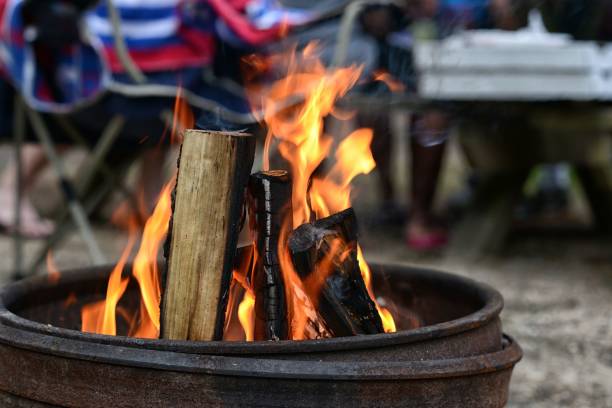Starting a campfire can be challenging, especially with unreliable methods. Fatwood Fire Starter Sticks offer an effortless solution. With their natural resin, they make igniting fires quick and easy. Discover the top ten secrets to using Fatwood and enhance your campfire experience effectively.
1. What Sets Fatwood Apart
High Resin Content Fatwood’s high resin content makes it a superior fire starter. The resin is a natural accelerant, ensuring quick ignition and a longer burn. It makes Fatwood a dependable choice for starting fires.
Natural vs. Synthetic Choosing Fatwood over synthetic fire starters is better for the environment and provides a cleaner burn. Fatwood contains no harmful chemicals, making it a safer and more sustainable option.
2. How to Select Premium Fatwood Fire Starter Sticks
Quality Indicators Look for Fatwood with a dark color and a strong resin scent. High-quality Fatwood will be dense with visible resin veins, ensuring effective ignition and prolonged burning.
Avoiding Common Pitfalls Avoid dry or brittle Fatwood. It should be flexible and slightly sticky, indicating it is full of natural resin.
3. The Best Techniques for Using Fatwood Effectively
Step-by-Step Guide Place a few Fatwood sticks in the center of your fire setup. Arrange kindling and logs around them in a teepee or log cabin structure. Light the Fatwood sticks and let your fire get started effortlessly.
Proper Fire Building Ensure proper airflow by not overcrowding your setup. Good air circulation helps the Fatwood and kindling catch fire more efficiently.
4. Comparing Fatwood with Other Fire Starters
Fatwood vs. Chemical Starters Fatwood is a natural alternative to chemical fire starters. It provides a cleaner, safer burn with no toxic fumes, making it a more eco-friendly choice.
Fatwood vs. Traditional Methods Traditional methods like newspapers or kindling alone can be unreliable. Fatwood simplifies the process and ensures a more consistent fire.

5. Versatile Uses for Fatwood Beyond Campfires
Home Fireplaces Fatwood is excellent for starting indoor fireplaces. It ignites quickly and burns cleanly, making it a convenient home-use choice.
Outdoor Grills Use Fatwood to light charcoal or wood in your grill. It helps achieve an even burn for better grilling results.
Emergency Preparedness Include Fatwood in your emergency survival kit. Its reliability makes it ideal for situations where a fire is needed quickly.
6. Adapting Fatwood for Different Weather Conditions
Wet and Damp Conditions Fatwood performs well even in damp conditions due to its resin content. Ensure sticks are as dry as possible for the best results.
Windy Days Create a windbreak around your fire to protect the Fatwood from breezes, which can affect its performance.
7. Maximizing Burn Time with Fatwood
Combining with Kindling Combine Fatwood with kindling for a more robust fire. The kindling will catch fire from the Fatwood, leading to a longer-lasting flame.
Fire Maintenance Add logs gradually to maintain a steady fire. Adjust the logs to keep the fire burning evenly.
8. Storing and Handling Fatwood for Longevity
Proper Storage Store Fatwood in a dry place to keep it in good condition. Moisture can reduce its effectiveness, so use airtight containers if possible.
Handling Tips Handle Fatwood carefully to avoid breaking it into smaller pieces. Larger pieces burn longer and more efficiently.
9. Troubleshooting Common Issues with Fatwood
Fatwood Won’t Ignite If Fatwood doesn’t ignite, check it’s dry and try a different ignition source. A fire starter tool can also help.
Short Burn Time If the fire burns too quickly, use more Fatwood or combine it with additional kindling and logs to extend the burn time.
10. Essential Accessories to Complement Fatwood Fire Starters
Fire Starter Tools Firestarter tools, such as additional fire starters or kindling, for enhanced performance.
Safety Gear Always use safety gear when starting and maintaining a fire. It includes gloves, a fire extinguisher, and a bucket of water or sand.
Conclusion
By these top ten secrets and techniques, you may make the maximum of Fatwood Fire Starter Sticks for a campfire experience. Ready to look at the benefits for yourself? Try Fatwood for your next adventure or home fireplace and enjoy a trouble-free fire-starting solution.
FAQ
1. How should I store Fatwood to keep it in good condition?
Store Fatwood in a dry place to prevent moisture from reducing its effectiveness. Using airtight containers can help maintain its quality.
2. Can I use Fatwood in different weather conditions?
Fatwood performs well even in damp conditions due to its resin content. For windy conditions, create a windbreak to help maintain the fire’s integrity.
3. How do I troubleshoot if my Fatwood won’t ignite?
Ensure the Fatwood is dry, and try a different ignition source. Sometimes, a fire starter tool can help achieve a successful ignition.
4. What accessories complement Fatwood Fire Starter Sticks?
Consider using additional fire starters, kindling, and safety gear like gloves and a fire extinguisher to enhance your fire-starting experience and ensure safety.

